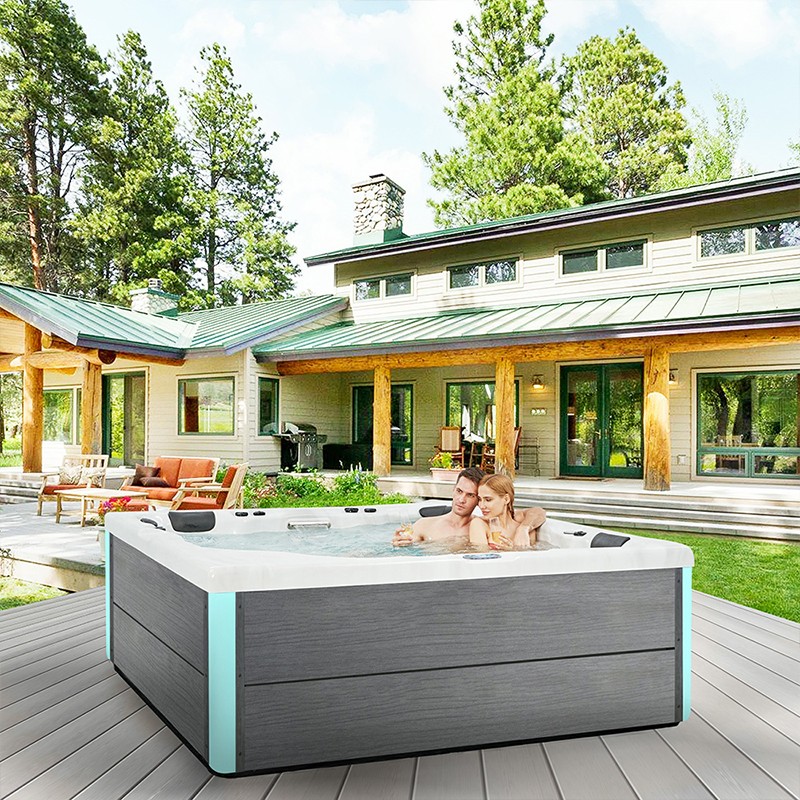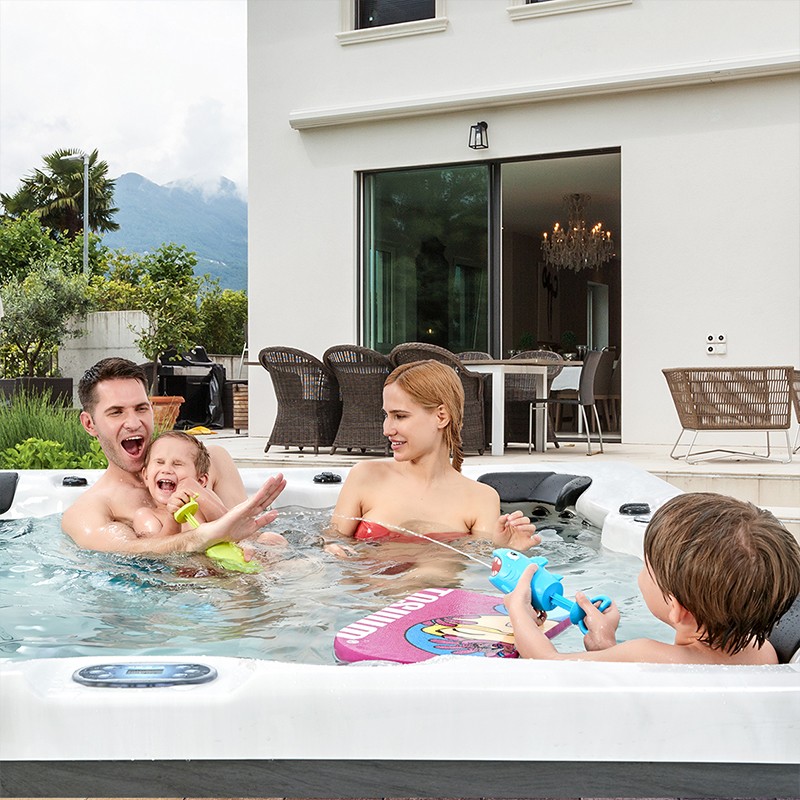
How much chemicals should I add to an outdoor spa jacuzzi?
2025-09-05 15:30Outdoor spa jacuzzis offer a deeply relaxing experience, and many people enjoy the warm water flow, massage features, and stress-relieving properties of the tub. However, as with all aquatic equipment, maintaining water quality is a critical part of ensuring smooth operation and user health.
A common question is, "How much chemicals should I add to an outdoor spa jacuzzi?" Chemicals directly impact water purity, the lifespan of the equipment, and the health of users, so understanding their proper use is crucial.
This article will detail how to add the appropriate amount of chemicals based on water quality requirements, frequency of use, and the volume of tub water to ensure hygienic water quality and a comfortable user experience.

Why do we use chemicals in outdoor spa jacuzzis?
First, we need to understand why adding chemicals to an outdoor spa jacuzzi is necessary. Even in spa jacuzzi tubs equipped with high-efficiency filtration systems, water cleanliness and disinfection still rely on chemicals. These chemicals have the following main functions:
1. Disinfection and Sterilization
Hot water and air often provide an ideal breeding environment for bacteria, fungi, and other pathogens. Outdoor spa jacuzzis, in particular, are often exposed to wind and sun, making them vulnerable to bacterial and algae growth. To prevent these bacteria and pathogens from causing skin infections or other health problems, the bathtub water must be effectively disinfected.
Common disinfecting chemicals include chlorine, bromine, and oxidants. They effectively kill bacteria, viruses, and algae in the water, ensuring clean water and reducing the risk of contamination.
2. pH Adjustment
The pH of outdoor spa jacuzzi water refers to the water's acidity and alkalinity. A pH that is too high or too low can affect the effectiveness of water chemicals and render the water unsuitable. The ideal pH range is generally between 7.2 and 7.8. If the pH is too low, the effectiveness of water chemicals will be reduced and may cause skin and eye irritation. If the pH is too high, calcium deposits in the water can form scale, which can damage the equipment.
3. Water Hardness Control
Water hardness refers to the concentration of calcium and magnesium ions in water. Excessive water hardness can cause scale buildup, affecting the operation of the heating and water circulation systems, and even damaging the heating elements of your outdoor spa jacuzzi. Adding a water softener can effectively reduce water hardness and prevent scale formation.
4. Preventing Algae Growth
Due to the constant exposure to sunlight in outdoor environments, algae can rapidly grow in the water, affecting water clarity and causing it to turn green. Algae inhibitors can prevent algae growth, keeping the water clear and clean.
5. Preventing Water Turbidity
Small particles and contaminants in the water can cause turbidity, affecting the user experience of your outdoor spa jacuzzi. Flocculants can help agglomerate these particles, removing them from the water and maintaining clear water clarity.

How should chemicals be added to meet the water quality requirements of your outdoor spa jacuzzi?
When adding chemicals, the dosage must be determined based on several factors, including the volume of water in the tub, the initial state of the water, how often the water is used, and the external environmental conditions. Here are some guidelines for common situations:
1. Measuring Water pH and Chemical Concentration
Before adding chemicals, you need to first measure the water pH and chemical concentration. Many test kits can help users measure water levels such as chlorine, bromine, pH, and water hardness. The results will directly affect the amount of chemical to add.
• pH: As mentioned above, the pH should be maintained between 7.2 and 7.8. If the pH is too low (below 7.2), a pH increaser should be added; if the pH is too high (above 7.8), a pH reducer should be used.
• Chlorine or Bromine Concentration: The disinfectant concentration should be adjusted based on frequency of use and water quality. Generally, 1 to 3 ppm (parts per million) of chlorine or bromine per gallon of water is recommended. Use a chlorine or bromine reagent to measure and adjust the concentration to ensure effective disinfection.
2. Calculating Bathtub Water Volume
Different bathtub sizes require different amounts of chemicals. First, you need to understand the tub's capacity—the total water volume, usually measured in US gallons or liters. This information can usually be found in the tub's owner's manual. If you can't find it, you can roughly estimate the volume by measuring the tub's length, width, and height.
3. Adjust the amount of chemicals added based on frequency of use
• Frequently used spa jacuzzi tubs: If the tub is used by multiple people weekly, more frequent chemical additions are required. Frequent changes in water quality will cause the water's chemicals to deplete faster, necessitating regular replenishment of disinfectants such as chlorine and bromine, as well as pH adjustments.
• Occasionally used spa jacuzzi tubs: If the tub is used less frequently, less chemical additions are required. Generally, water quality should be checked and adjusted approximately every three to five days.
4. Environmental Impacts
Outdoor spa jacuzzi tubs are more susceptible to environmental factors than indoor tubs. For example, strong sunlight, high temperatures, and windy conditions can promote algae growth, necessitating the addition of additional algae inhibitors. Rainwater, dust, and other contaminants can also enter the tub, so regular water quality checks are necessary to ensure they remain clean.

Outdoor spa jacuzzi: How to accurately add chemicals?
When adding chemicals, the following steps will ensure they work accurately and effectively:
1. Adjust chemical dosage based on test results
Use a test kit to test the water quality to measure pH, chlorine or bromine concentration, and water hardness. Based on the test results, adjust the chemical dosage as needed.
2. Add chemicals gradually
To avoid overdosing or uneven distribution of chemicals, it's recommended to add chemicals gradually. Start by adding a small amount of chemical. After the water circulation system has been running for a while, retest the water to ensure the chemical concentration is within the specified range. If further adjustments are needed, continue adding small amounts until the desired concentration is reached.
3. Follow product instructions
When using any chemical, it's important to strictly follow the product instructions, especially when adding disinfectants and pH adjusters. The dosage of each product will vary depending on the volume and quality of the water in your outdoor spa jacuzzi. Using too many chemicals can cause water quality problems and may cause skin and eye irritation.
4. Keep the circulation system running
After adding chemicals, always run the outdoor spa jacuzzi's water circulation system. This helps evenly distribute the chemicals, ensuring the water throughout the tub is fully conditioned and disinfected. Allow the circulation system to run for 15 to 30 minutes, then test the water to ensure all chemicals have been effectively dissolved.

Common Chemicals and Usage Recommendations
The following are some common chemicals and usage recommendations to help users adjust the amount of chemicals used based on the water quality of their outdoor spa jacuzzi:
1. Chlorine
Chlorine is one of the most common spa jacuzzi tub disinfectants. It effectively kills bacteria, disinfects, and inhibits algae growth. Common forms of chlorine include calcium chloride (Ca(ClO)2) and trichloroisocyanuric acid (TCCA). The recommended dosage is 1-3 ppm per gallon of water. Generally, add as needed to maintain this range.
2. Bromine
Bromine is a disinfectant similar to chlorine and is commonly used in hot springs and spa jacuzzi tubs. Compared to chlorine, bromine is more resistant to changes in water temperature and pH, making it suitable for high-temperature water. Add 1-3 ppm of bromine per gallon of water.
3. pH Adjuster
After testing the pH of your outdoor spa jacuzzi water, if it is below 7.2 or above 7.8, use a pH increaser (such as sodium carbonate) or a pH decreaser (such as sulfuric acid). Adjust the pH based on the test results and according to the instructions.
4. Algae Inhibitor
During strong sunlight and warm weather, algae may rapidly grow in the water. This can be prevented by adding an algae inhibitor. It should generally be added monthly to maintain clear water quality.
5. Water Hardness Adjuster
Excessive water hardness can easily lead to scaling and caking. Use a water hardness adjuster (such as a softener) to reduce water hardness and prevent damage to the equipment.
Is Lovia Spa a reliable manufacturer for long-term cooperation?
Yes, Lovia Spa, established under Guangzhou HuanTong Industrial Co., Ltd., is a trusted manufacturer with over 35 years of production experience in the spa and hot tub industry. We focus on long-term business partnerships, offering consistent product quality, reliable lead times, and discounted wholesale prices.
Whether you're sourcing a single container or planning yearly bulk procurement, we deliver competitive quotes, customized support, and dedicated post-sales services.
